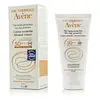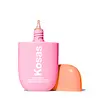What's inside
What's inside
 Key Ingredients
Key Ingredients

 Benefits
Benefits

 Concerns
Concerns

 Ingredients Side-by-side
Ingredients Side-by-side

Water
Skin ConditioningTitanium Dioxide
Cosmetic ColorantIsodecyl Neopentanoate
EmollientTriethylhexanoin
MaskingC12-15 Alkyl Benzoate
AntimicrobialGlycerin
HumectantCyclopentasiloxane
EmollientPolyglyceryl-4 Isostearate
EmulsifyingAlumina
AbrasiveCetyl PEG/PPG-10/1 Dimethicone
EmulsifyingHexyl Laurate
EmollientC30-45 Alkyl Methicone
EmollientStearic Acid
CleansingC30-45 Olefin
Skin ConditioningCyclohexasiloxane
EmollientCaprylic/Capric Triglyceride
MaskingCaprylyl Glycol
EmollientDisodium EDTA
CI 77492
Cosmetic ColorantOctyldodecanol
EmollientPentaerythrityl Tetra-Di-T-Butyl Hydroxyhydrocinnamate
AntioxidantSilica Dimethyl Silylate
EmollientSilk Amino Acids
HumectantSodium Chloride
MaskingSorbic Acid
PreservativeTalc
AbrasiveCI 77891
Cosmetic ColorantTocopheryl Glucoside
EmollientXanthan Gum
EmulsifyingWater, Titanium Dioxide, Isodecyl Neopentanoate, Triethylhexanoin, C12-15 Alkyl Benzoate, Glycerin, Cyclopentasiloxane, Polyglyceryl-4 Isostearate, Alumina, Cetyl PEG/PPG-10/1 Dimethicone, Hexyl Laurate, C30-45 Alkyl Methicone, Stearic Acid, C30-45 Olefin, Cyclohexasiloxane, Caprylic/Capric Triglyceride, Caprylyl Glycol, Disodium EDTA, CI 77492, Octyldodecanol, Pentaerythrityl Tetra-Di-T-Butyl Hydroxyhydrocinnamate, Silica Dimethyl Silylate, Silk Amino Acids, Sodium Chloride, Sorbic Acid, Talc, CI 77891, Tocopheryl Glucoside, Xanthan Gum
Zinc Oxide 21.7%
Cosmetic ColorantWater
Skin ConditioningC13-15 Alkane
SolventCaprylic/Capric Triglyceride
MaskingButyloctyl Salicylate
Skin ConditioningPropanediol
SolventMica
Cosmetic ColorantPolyglyceryl-2 Dipolyhydroxystearate
Skin ConditioningPolyglyceryl-3 Diisostearate
EmulsifyingSilica
AbrasiveC12-15 Alkyl Benzoate
AntimicrobialPolyglyceryl-3 Polyricinoleate
EmulsifyingGalactoarabinan
Allantoin
Skin ConditioningFructooligosaccharides
HumectantBioflavonoids
Skin ConditioningGlycoproteins
Skin ConditioningBisabolol
MaskingCeramide Ng
Skin ConditioningLactic Acid
BufferingSodium Hyaluronate
HumectantPalmitoyl Hexapeptide-12
Skin ConditioningCyamopsis Tetragonoloba Gum
Emulsion StabilisingTocopheryl Acetate
AntioxidantDisteardimonium Hectorite
StabilisingGlycerin
HumectantPolyhydroxystearic Acid
EmulsifyingTribehenin
EmollientIsostearic Acid
CleansingLecithin
EmollientXanthan Gum
EmulsifyingSodium Chloride
MaskingPhytic Acid
Pentylene Glycol
Skin ConditioningPhenethyl Alcohol
MaskingCI 77891
Cosmetic ColorantCI 77491
Cosmetic ColorantCI 77492
Cosmetic ColorantZinc Oxide 21.7%, Water, C13-15 Alkane, Caprylic/Capric Triglyceride, Butyloctyl Salicylate, Propanediol, Mica, Polyglyceryl-2 Dipolyhydroxystearate, Polyglyceryl-3 Diisostearate, Silica, C12-15 Alkyl Benzoate, Polyglyceryl-3 Polyricinoleate, Galactoarabinan, Allantoin, Fructooligosaccharides, Bioflavonoids, Glycoproteins, Bisabolol, Ceramide Ng, Lactic Acid, Sodium Hyaluronate, Palmitoyl Hexapeptide-12, Cyamopsis Tetragonoloba Gum, Tocopheryl Acetate, Disteardimonium Hectorite, Glycerin, Polyhydroxystearic Acid, Tribehenin, Isostearic Acid, Lecithin, Xanthan Gum, Sodium Chloride, Phytic Acid, Pentylene Glycol, Phenethyl Alcohol, CI 77891, CI 77491, CI 77492
 Reviews
Reviews

Ingredients Explained
These ingredients are found in both products.
Ingredients higher up in an ingredient list are typically present in a larger amount.
C12-15 Alkyl Benzoate is made up of Benzoic Acid and long chain alcohols. It has a low molecular weight.
C12-15 Alkyl Benzoate is an emollient and texture enhancer. Due to its solubility, it is often used in sunscreens to help evenly distribute active ingredients.
As an emollient, C12-15 Alkyl Benzoate helps soften and hydrate your skin. Emollients create a film on your skin that traps moisture within.
This ingredient has been reported to cause eye irritation.
Learn more about C12-15 Alkyl BenzoateThis ingredient is an emollient, solvent, and texture enhancer. It is considered a skin-softener by helping the skin prevent moisture loss.
It helps thicken a product's formula and makes it easier to spread by dissolving clumping compounds.
Caprylic Triglyceride is made by combining glycerin with coconut oil, forming a clear liquid.
While there is an assumption Caprylic Triglyceride can clog pores due to it being derived from coconut oil, there is no research supporting this.
Learn more about Caprylic/Capric TriglycerideCi 77492 is also hydrated iron III oxide. It's sole purpose is to give a yellow hue to products.
Iron III oxides are classified as inorganic chemicals for coloring.
Synthetically created Ci 77492 is considered safer than those naturally found. This is because the synthetically created version may contain less impurities. Iron oxides are generally non-toxic and non-allergenic.
Learn more about CI 77492Ci 77891 is a white pigment from Titanium dioxide. It is naturally found in minerals such as rutile and ilmenite.
It's main function is to add a white color to cosmetics. It can also be mixed with other colors to create different shades.
Ci 77891 is commonly found in sunscreens due to its ability to block UV rays.
Learn more about CI 77891Glycerin is already naturally found in your skin. It helps moisturize and protect your skin.
A study from 2016 found glycerin to be more effective as a humectant than AHAs and hyaluronic acid.
As a humectant, it helps the skin stay hydrated by pulling moisture to your skin. The low molecular weight of glycerin allows it to pull moisture into the deeper layers of your skin.
Hydrated skin improves your skin barrier; Your skin barrier helps protect against irritants and bacteria.
Glycerin has also been found to have antimicrobial and antiviral properties. Due to these properties, glycerin is often used in wound and burn treatments.
In cosmetics, glycerin is usually derived from plants such as soybean or palm. However, it can also be sourced from animals, such as tallow or animal fat.
This ingredient is organic, colorless, odorless, and non-toxic.
Glycerin is the name for this ingredient in American English. British English uses Glycerol/Glycerine.
Learn more about GlycerinChances are, you eat sodium chloride every day. Sodium Chloride is also known as table salt.
This ingredient has many purposes in skincare: thickener, emulsifier, and exfoliator.
You'll most likely find this ingredient in cleansers where it is used to create a gel-like texture. As an emulsifier, it also prevents ingredients from separating.
There is much debate on whether this ingredient is comedogenic. The short answer - comedogenic ratings don't tell the whole story. Learn more about comegodenic ratings here.
The concensus about this ingredient causing acne seems to be divided. Research is needed to understand if this ingredient does cause acne.
Scrubs may use salt as the primary exfoliating ingredient.
Learn more about Sodium ChlorideWater. It's the most common cosmetic ingredient of all. You'll usually see it at the top of ingredient lists, meaning that it makes up the largest part of the product.
So why is it so popular? Water most often acts as a solvent - this means that it helps dissolve other ingredients into the formulation.
You'll also recognize water as that liquid we all need to stay alive. If you see this, drink a glass of water. Stay hydrated!
Learn more about WaterXanthan gum is used as a stabilizer and thickener within cosmetic products. It helps give products a sticky, thick feeling - preventing them from being too runny.
On the technical side of things, xanthan gum is a polysaccharide - a combination consisting of multiple sugar molecules bonded together.
Xanthan gum is a pretty common and great ingredient. It is a natural, non-toxic, non-irritating ingredient that is also commonly used in food products.
Learn more about Xanthan Gum